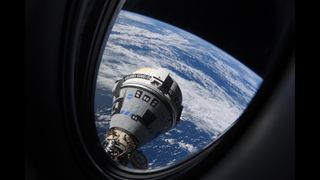
Boeing's first astronaut mission for NASA won't lift off this year after all.
The company had been aiming to launch Crew Flight Test (CFT), the first-ever crewed mission of its Starliner capsule, toward the International Space Station (ISS) sometime in December. But technicians need more time to address a few issues identified on Orbital Flight Test 2 (OFT-2), an uncrewed jaunt to the ISS that Starliner made in May, NASA and Boeing representatives announced today (Aug. 25).
"Currently, we're targeting a launch date as early as February of 2023," Steve Stich, manager of NASA's Commercial Crew Program, said during a call with reporters today.
NASA and Boeing will likely shoot for early February, he and others on the call added, identifying that timeframe as a relatively open window in an otherwise busy stretch for ISS operations. (The first few months of 2023 will see the launch of three other crewed missions to the orbiting lab, if all goes according to plan — SpaceX's Crew-6 flight for NASA and Ax-2 mission for Houston-based company Axiom Space, and a Russian Soyuz flight — as well as two robotic resupply liftoffs.)
Related: Boeing's Starliner, a next-generation spaceship
Like SpaceX, Boeing holds a multibillion-dollar deal to fly astronauts to and from the ISS for NASA. SpaceX is already fully up and running, having launched four operational crewed missions to the orbiting lab using its Dragon capsule and Falcon 9 rocket. But Boeing isn't there yet.
The company notched a big milestone with OFT-2, an uncrewed shakeout cruise that showed Starliner can get safely to and from the ISS. But the six-day flight did not go perfectly smoothly, as the newly announced CFT delay attests.
Get the Space.com Newsletter
Breaking space news, the latest updates on rocket launches, skywatching events and more!
Post-flight reviews revealed four main issues requiring troubleshooting or additional work, Mark Nappi, Starliner vice president and program manager at Boeing, said during today's call.
One such issue involved the premature shutdown of two of Starliner's orbital maneuvering and attitude control (OMAC) thrusters. Investigators have determined that the problem likely resulted from an incursion of debris, the type of which remains unclear, Nappi said.
Starliner also experienced issues with the smaller reaction control system (RCS) thrusters in its crew and service modules during OFT-2, as well as anomalously high pressure readings in its thermal control system. And Starliner's Vision-based Electro-optical Sensor Tracking Assembly (VESTA), which helped it rendezvous and dock with the ISS, didn't behave exactly as expected, though it did perform its main task well, Nappi said.
Boeing has mapped out fixes for all of these issues and is confident they'll be fully vetted and emplaced by early February, he added. For example, the pressure problem can be alleviated by removing some unnecessary filters in the thermal control system. And VESTA was collecting more data than Starliner's onboard computers could handle, which can be addressed with a tweak to the capsule's flight software, Nappi said.
"We looked at all these systems," he said. "There were areas that we needed to go do a little bit more work on the systems. And we plugged that into the plan, and that's what moved us out by a month, five weeks or so."
CFT will send NASA astronauts Barry "Butch" Wilmore and Suni Williams to and from the ISS. It's expected to last six days, the same duration as OFT-2. If all goes well with CFT, Starliner will be cleared to start flying operational astronaut missions for NASA.
OFT-2 was Starliner's second crack at an uncrewed flight to the ISS. During the original OFT, which launched in December 2019, Starliner suffered a number of software problems and got stranded in an orbit too low for a meetup with the station.
Mike Wall is the author of "Out There" (Grand Central Publishing, 2018; illustrated by Karl Tate), a book about the search for alien life. Follow him on Twitter @michaeldwall. Follow us on Twitter @Spacedotcom or on Facebook.
Join our Space Forums to keep talking space on the latest missions, night sky and more! And if you have a news tip, correction or comment, let us know at: community@space.com.

Michael Wall is a Senior Space Writer with Space.com and joined the team in 2010. He primarily covers exoplanets, spaceflight and military space, but has been known to dabble in the space art beat. His book about the search for alien life, "Out There," was published on Nov. 13, 2018. Before becoming a science writer, Michael worked as a herpetologist and wildlife biologist. He has a Ph.D. in evolutionary biology from the University of Sydney, Australia, a bachelor's degree from the University of Arizona, and a graduate certificate in science writing from the University of California, Santa Cruz. To find out what his latest project is, you can follow Michael on Twitter.
